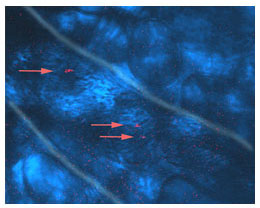WEST LAFAYETTE, Ind., Oct. 28 -- Researchers at Purdue University have taken a step toward developing a new type of ultrasensitive medical imaging technique that works by shining a laser through the skin to see tiny gold nanorods injected into the bloodstream. The researchers say the technique could lead to advances in early cancer detection.
In tests with mice, the nanorods yielded images nearly 60 times brighter than conventional fluorescent dyes, including rhodamine, commonly used for a wide range of biological imaging to study the inner workings of cells and molecules. The nanorods might be used to develop an advanced medical imaging tool for the early detection of cancer, said Ji-Xin Cheng, a Purdue assistant professor of biomedical engineering. 
Gold nanorods, which fluoresce red, were photographed inside the blood vessels of a live mouse by researchers in Purdue's Weldon School of Biomedical Engineering and department of chemistry. In these tests, the nanorods yielded images nearly 60 times brighter than conventional fluorescent dyes, and could lead to advances in earlier cancer detection. (Purdue University photo courtesy of Weldon School of Biomedical Engineering and department of chemistry)
The gold rods are about 20 nm wide and 60 nm long, or roughly 200 times smaller than a red blood cell, and researchers say they represent a possible way to overcome barriers in developing advanced medical imaging techniques that use light to analyze blood vessels and underlying tissues.
"One obstacle is that light in the visible spectrum does not pass through tissue very well," said Alexander Wei, an associate professor of chemistry who worked the researchers. Imaging methods might be developed using laser pulses in longer wavelengths of light, beyond the visible range in a region of the spectrum called near-infrared.
"There is a window of light in the near-infrared, wavelengths from about 800 to 1300 nm, which could be harnessed for new imaging technologies," Wei said.
Tiny gold rods with a certain aspect ratio of length to width shine brightly when illuminated by light in this spectral region. The gold nanorods are ideal for a type of imaging called two-photon fluorescence, which provides higher contrast and brighter images than conventional fluorescent imaging methods. Photons are the individual particles that comprise light. In two-photon fluorescence, two photons hit the nanorod at the same time. Cheng is applying two-photon fluorescence and other non-linear optical effects to develop imaging methods that provide improved contrast over conventional technologies.
The researchers injected the nanorods into mice and then took images of the tiny structures as the nanorods flowed through blood vessels in the animals' ears. Individual nanorods proved to be 58 times brighter than the two-photon fluorescence from a single rhodamine molecule. Within 30 minutes after being injected, the nanorods could no longer be observed in the animals' blood, presumably because the rods had been filtered out by the kidneys.
"To be able to detect cells at an early stage of disease such as cancer, it is important to have a reliable technique that has sensitivity at the single-particle level," Wei said. "The gold nanorods demonstrate that Cheng's nonlinear imaging methods are capable of this level of detection."
The researchers' findings are detailed in a paper in Proceedings of the National Academy of Sciences. It was written by Haifeng Wang, a postdoctoral biomedical engineering research associate; Terry B. Huff, a chemistry graduate teaching assistant; Daniel A. Zweifel, a chemistry graduate student; Wei He, a chemistry graduate research assistant; chemistry professor Philip S. Low, Wei and Cheng, all members of Purdue's Weldon School of Biomedical Engineering and/or department of chemistry. The research was funded by the National Institutes of Health and is affiliated with the Birck Nanotechnology Center and the Bindley Bioscience Center, both in Purdue's Discovery Park, the university's hub for interdisciplinary research.
For more information, visit: www.purdue.edu/bme